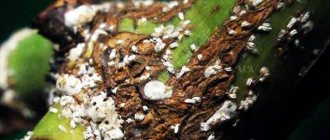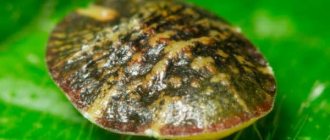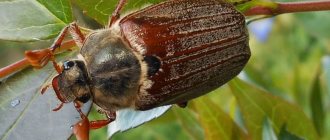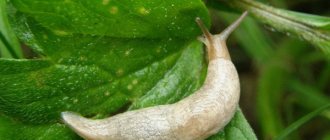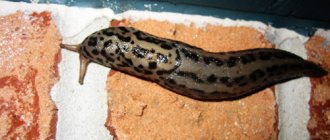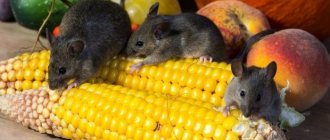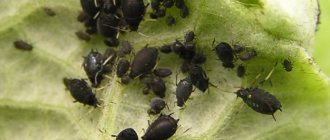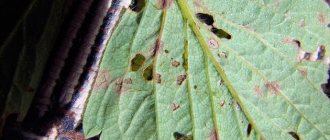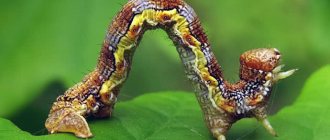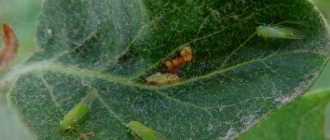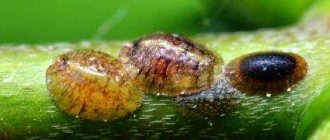3.7
(3)
Gardening is not about harvesting a long-awaited harvest. Or rather, this is the final part of the work that has to be put in every day throughout the year. Yes, yes, a gardener works all year round - in the fall he prepares trees and bushes for winter, in the winter he protects them from rodents and frost, in the spring he takes care of providing the plants with the substances necessary for growth, in the summer he removes weeds, and protects them from birds. But most of the time during the warm period we have to fight insect pests. In this article we will tell you why scale insects appear on apple trees and how to fight them using folk and chemical treatment methods.
How to recognize an enemy in the garden
There are several types of scale insects. They are called that because of their peculiar waxy shell. It reliably protects them from enemies and various drugs.
Scale insects on apple trees are a fairly common pest, which, if possible, should be combated as early as possible.
The two sexes differ significantly. Females do not have wings, legs, and some species do not even have eyes. The scutellum of females is more convex and has a rounded shape. Due to the lack of legs, females do not move. The size of males is slightly smaller; they have wings, eyes, and limbs. The shell of males is elongated. Males also have oral organs. When the breeding process is completed, the males die.
Traditional methods
Folk recipes for the pest There are many folk methods that have been tested by gardeners for decades to combat scale insects on pears, apple trees, peach trees, etc.:
- Using a solution of grated laundry soap and chopped garlic in a 1:1:3 ratio with water. Sick plants need to be sprayed and washed with clean water from a hose after a day. The procedure must be repeated every 3 days until the parasites disappear.
- Onion infusion is made from 4 onions, poured 1 liter of water, leave for 3-4 hours, then strain and use for spraying.
- Pour 100 g of fresh crushed hot pepper into a liter of water and cook for 10-15 minutes, then leave for a day and filter. During processing, green soap is added at the rate of: per 1 liter of water, 10 g of pepper tincture and 5 g of soap;
- Pour 300 g of wood ash into 1 liter of boiling water, cook for 30 minutes, cool and strain, dilute with water to 10 liters and spray the plantings.
- Infuse 3-4 kg of fresh celandine in 10 liters of water for a day; it can be used for watering and treating trees.
Types of garden scale insects
There are a huge number of species of scale insects known - about 2,500. The vast majority of them infect plants that are grown indoors or in greenhouses. Plants growing in open ground are threatened by only a few species of scale insects. Read also the article: → “Ways to combat scale insects in the garden, tips for treating trees.”
This photo shows a close-up of the Californian scale insect.
There are several types of scale insects:
| Name | Description of females | Description of males | Signs of defeat |
| Californian | The shields are round in shape. Color – gray, sometimes brownish. Body up to 0.2 cm long, flat, lemon-colored. | The shells are grayish, oval in shape. Their size is 1 mm. The body of males is light orange. | First, oblong cracks appear on the branches and trunk. Then cracks located in the transverse direction are added to them. Red spots form on the fruits and leaves. They merge over time. 2-3 years after infection, young plants die. |
| mulberry | The size of females is 0.2 cm. The scutellum is rounded, white, less often gray. The body is light orange or yellow in color. | Males have an oblong white shield, on which there is a pair of longitudinal grooves. The body of adult males is approximately 1 mm long and yellow in color. They have a pair of wings, legs, and antennae. | The plant weakens, the fruits appear much smaller in size. Due to the appearance of stains, they become unsuitable for food and sale. |
| Purple | Females are 1 mm long. Their body is oval, almost pentagonal in shape, and purple in color. The scutellum is white, up to 2 mm in size. | Males are winged and reddish-violet in color. Their size is approximately 1 mm. The scutellum is whitish in color, flat in shape, smaller in size than the body. | Affects terrestrial plant organs. The pest can be noticed first along the main vein of the leaves and on the stalk. After the insect appears, the leaves begin to discolor. The fruits lose their commercial quality due to the appearance of purple-red spots on them. |
| Comma apple | The body itself is less than 1 mm in size and has a pear-shaped shape. The scutellum is oblong, brown. | Males are winged. At the top of the abdomen they have a long process. The color of males is reddish-gray. | Infestation is indicated by spots that appear in the places where the pest has settled. |
| Oyster | The body is short oval. May have a lemon or greenish-yellow color. The color of the scutellum is grayish-olive. The shape is slightly flattened in the central part. | Males are winged - yellowish-orange. They have a black band on their back. The scutellum is about 1 mm in size, short-oval. | They usually affect leaves, branches, and trunks, located on their undersides. Fruits are rarely affected. |
Popular insecticides
- before processing, it is better to take the flower pot out onto the balcony or loggia;
- processing is carried out with gloves and glasses. A respirator is required!
"Aktellik"
This is a fairly effective remedy. They spray it on indoor plants and water the soil in pots. Can be used for treating garden crops and storage facilities (including barns).
1.5-2 ml of the product is dissolved in one liter of water. The resulting solution is sprayed onto the entire plant. The remains can be poured into the soil, under the roots.
Affects insects over a period of several minutes to several hours. The speed of action is determined by the state of the insect and the air temperature.
Protection lasts up to three weeks. Warehouses can be processed once every eight months.
- prevents the reappearance of pests;
- there is no addiction in insects;
- can be mixed with other insecticides to achieve maximum effect;
- seed treatment is permissible (for prevention).
- unpleasant odor;
- dangerous for pets and children;
- not recommended for residential use.
"Aktara"
It is used to combat various types of pests. The product can be sprayed on plants or injected directly into the soil.
For indoor plants, 0.5-1 ml of the product from a bottle (9 ml) is dissolved in one liter of water. It is best to pour the solution into the soil. Then the poison will permeate all the leaves and destroy the scale insect.
Treatment of trees and plants in open ground is carried out using a sprayer.
First, one sachet of dry insecticide (4 g) is diluted in 1 liter of water. The resulting milk is diluted with water in the sprayer tank. For a quarter tank of water you will need 600 ml of flower treatment product, 250 ml for currants and trees.
The pests die within a day.
- efficiency;
- can be used with growth stimulants;
- not addictive.
- unpleasant odor;
- the product is toxic to bees;
- Treatment cannot be carried out in a residential area.
"Bankol"
It is used for spraying both indoor plants and gardens.
Has a contact effect. Damage to the nervous system and paralysis in pests occurs within one to two days.
In floriculture, a solution of 0.5-0.7 g per liter of water is used.
Advantages:
- low toxicity to humans and animals;
- is poorly washed off from plants by rain;
- it is permissible to combine with growth stimulants;
- has no smell.
- most effective at high air temperatures;
- not used for garden treatment.
"Bitoxibacillin"
In addition to the insecticide, it contains bacterial
complex. Acts on pests through intestinal damage. Within a day the insects cannot feed. Three days later, their mass death begins.
35 ml of product dissolves in 5 liters of water. You can treat indoor plants and trees.
- repeated processing is required;
- efficiency in open ground depends on the ambient temperature (permissible minimum +18 degrees);
- cannot be used without personal protective equipment.
The nodule weevil can eat up to two square meters in one day. cm greenery. Read here how to deal with this pest.
The fat fir leafroller is slightly larger than other types of leafrollers. You will find a detailed description of this insect in the article at https://stopvreditel.ru/rastenij/lesov/listovertka.html link.
How to determine plant damage
First of all, you can recognize a lesion by the appearance of plaque. It is sticky and very similar to syrup. Gardeners call this coating honeydew or honeydew. These secretions are left by sucking insects - one of the types of scale insects. The very first harm from this is serious damage from sooty fungus, which actively develops in the secretions.
This photo shows a close-up of the false scale insect; this pest can appear not only on the apple tree, but also on other fruit plants.
If plaque appears, you need to carefully examine the plants, especially the trunks and branches. You may notice off-white or grayish-brown plaques on them. These are adult larvae and females sucking the juices from the plant. Within a year after infection, new tissue will begin to grow in the damaged areas. Because of this, the surface of the bark becomes lumpy.
The leaves on the tree or bush will begin to turn red, become deformed and then fall off, and the plant itself will stop growing and developing. If nothing is done, in the third year the infected branches will begin to dry out en masse and the bark will crack. During this period, it is unlikely that it will be possible to effectively combat the pest: the defeat will be massive, and the damage has already been significant. It is best to prevent this and begin exterminating the scale insect as soon as it is noticed on the site.
Fruit rot (moniliosis)
Infection with it begins at the flowering stage, but mass disease begins in mid-summer, during the apple filling period.
Small, rapidly growing soft spots appear on them, covered with a grayish-white speckled coating - spores. The fruits become unfit for consumption. First of all, puncture sites by pests, hail holes and cracks formed by scab are damaged. The spread of the disease is also facilitated by wind, which carries spores over considerable distances. Apples remaining on trees or fallen apples are a source of re-infestation. Fruits stored for storage also quickly become infected when they come into contact with sick people.
The main factors contributing to the spread of the disease include:
- cold, long spring;
- increased air humidity;
- bark damage and cracks;
- damage to fruits by bites of codling moths or other harmful insects;
- high susceptibility of the plant to this type of disease;
- lack of tree care: infection occurs through contact with already infected fruits and branches and infected fallen fruits and bark;
- contaminated containers in which new crops are stored;
- pruning the plant with undisinfected tools containing fungal spores.
A measure to combat apple tree fruit rot is spraying with Bordeaux mixture or its analogues, copper oxychloride, topsin M. The timing of treatment of fruits affected by monoliosis is the same as when combating scab.
Causes of infection of garden trees
Usually the scale insect gets into the area with newly acquired seedlings or grafting material. Sometimes their larvae are carried by birds or the wind (if the affected trees are not very far away).
To avoid this, you need to carefully inspect the cuttings or young seedlings you purchase. Even if nothing was noticeable on them, after planting the trees must be inspected frequently and the entire garden systematically examined. Gardeners recommend paying the most attention to the appearance of plants.
Tip #1. If you notice the slightest changes, red dots, sticky plaque, start treatment immediately.
Preventive control measures
There are several important rules, the observance of which will help preserve the garden and prevent infection:
- Thin out the crowns in a timely manner.
- Constantly remove branches that are dry or damaged. At the same time, it is necessary to remove root shoots and dried trees.
- Clean the bark on skeletal branches and trunks that has fallen away from the trunk or is damaged.
- Properly fertilize and water trees. If the plants are strong, they are rarely affected by pests.
The scale insect usually appears on trees, or rather on poles or branches; sometimes you can see the scale insect on green branches.
Pest control in various ways
Due to the rapid reproduction of this type of insect, it is very difficult to defeat the pest. In addition, it has excellent protection against toxic chemicals - a shield. But the complexity of the struggle does not mean it is ineffective. To defeat this dangerous insect pest, there are many different methods of action:
- Mechanical. Effective at the initial stage of infection. This option provides that the insect is simply eliminated with swabs or sponges soaked in alcohol. In addition, the affected branches are removed. But they are not left, but must be burned.
- Folk. This option is acceptable when there are still few scale insects on the plant. Trees are sprayed with a solution of pepper, garlic, and celandine. As an option, make an infusion of tobacco, dilute machine oil with a soap solution. Such means will help in the fight against young larvae, but it is unlikely that it will be possible to get rid of adult insects in this way.
- Biological. We are talking about entomophages. They will help get rid of mulberry scale. A biological method is also the use of fungicides that are based on pathogenic nematodes or fungi. Such drugs are Nemabact and Aversectin. These remedies can be effectively combated against the Californian scale insect.
- Chemical. Pesticides are indispensable in the fight against such a serious enemy of gardens. But even potent insecticides may not give the expected result if you do not take into account the development cycle of the scale insect. It is best to use chemicals at the time when the larvae appear - during this period they are vulnerable and can be eliminated.
In this photo you can see what a tree pillar looks like that has been affected by a pest called the comma scale insect.
RELATED MATERIALS
9
Cabbage is loved by all kinds of pests - cabbage aphids, cruciferous flea beetles, cabbage weevils, ...
2
61
Currants have many enemies. They deprive us of the harvest and often spread dangers for currants...
2
The main problem of early flowering peonies is the defeat of gray mold (botrytis) - their...
3
Whiteflies are related to aphids and damage plants in a similar way. They are often called flies...
1
Spider mites are polyphagous pests that damage plants both outdoors and indoors...
After a dry start to the summer, the artichoke became infested with aphids. Especially a lot of black aphids have accumulated...
Tips from pest control experts
Gardeners who have already dealt with this insidious enemy advise:
- There is no need to collect scale insects by hand - this way only one shield is removed, and the insect itself remains. In addition, almost mature larvae may appear under the shield. Removing the shell will allow them to go free and, as a result, instead of eliminating the enemy, you can get an additional huge number of new individuals.
- You should be very careful with chemicals - strictly follow the instructions and use less toxic drugs first. This will prevent harm to other plants and pets.
- Before you start treating affected plants with chemicals or planting insect predators, you need to thoroughly water everything that grows nearby - bushes, trees and even grass.
Recommendations from gardeners
Some advice from agricultural technicians:
- Don't try to crush insects. This will lead to the removal of protective shields, which are easily and quickly restored. If they hit a female, the eggs can fall to the ground and larvae emerge.
- The use of chemicals must be careful. They can destroy beneficial insects and harm people. Before treatment, test a small area and observe the effect.
- Alternate means to avoid addiction. This applies to both home and folk remedies.
Features of plant processing
It is not for nothing that scale insects are considered difficult to eradicate pests - thanks to their excellent protection, they can even withstand chemical treatment. Sometimes a scraper or wire brush may be more effective. Mechanical cleaning of tree bark with their help eliminates both adult individuals and eggs hidden under the shell. If the pest colony has grown very large, this method will not help get rid of it.
Tip #2. The only way out is to cut off the infected sections of the branches (and possibly the entire plant) and burn it.
It is easier to eliminate scale insects on infected seedlings: you need to treat them with a brush and then wash them with a solution of laundry soap. To prevent the whole procedure from being useless, experienced gardeners recommend treating the soil around the plants with chemicals or replacing it, which is much more effective.
The photo shows a close-up of a comma-shaped scale insect that has settled on a branch of a fruit tree.
Large trees are more difficult to wash, so after treating them with a brush or scraper, treat them with one of the preparations given in the table below.
| Name | Advantages | Flaws |
| Phosbecid (Aktelik) | The drug can be used to treat seeds. Pests don't get used to it. The drug completely eliminates insects and they do not appear again. | The presence of an unpleasant odor. High toxicity. |
| Aktara | Recognized as an effective drug. Re-infection is prevented. | Unpleasant smell. The drug is dangerous for bees. |
| Bitoxibacillin | Has no smell. The drug is safe, completely harmless to animals and people. This drug consists of live bacteria, which destroy scale insects at all stages of their development. | Re-processing required. Can only be processed when the outside temperature is above +18 degrees. During processing, be sure to use a respirator and wear gloves. |
| 30 Plus | Environmentally friendly product. It is a mineral-oil emulsion created on the basis of petroleum jelly. Removes many types of pathogenic flora and spores of parasitic fungi. | Dangerous for bees. It is allowed to use only in spring, before the flowers have bloomed. |
If the infection is severe, you can treat it after flowering using one of the following means:
- Karbofos.
- Rovikurt.
- Rogor.
Use of catch belts
One of the effective methods of pest control is trapping belts. Their operating principle is based on trapping insects.
The main types of such devices:
- Funnel-shaped. Thick paper or cardboard is wrapped around the lower part of the trunk so that a socket is formed at the bottom, and the upper part of the belt is adjacent to the wood. The structure is attached by wrapping it with thread, tape or wire. The gaps are covered with clay or garden pitch.
- Double-sided funnel. They do the same, but leave the sockets on both sides.
- Glue. The material is tied to the trunk and then lubricated with long-drying glue. Typically, adhesive compounds against rodents or insects are used.
The height of the belt placement varies within 0.5–1 m from the ground. The optimal belt width is 25 cm
It is important that the fishing device does not touch the crown
Adhesive belts are checked daily. Insects caught in traps are destroyed.
A trapping belt is an effective means of preventing pests and does not harm pets or the environment. It is allowed to be used even during harvest.
